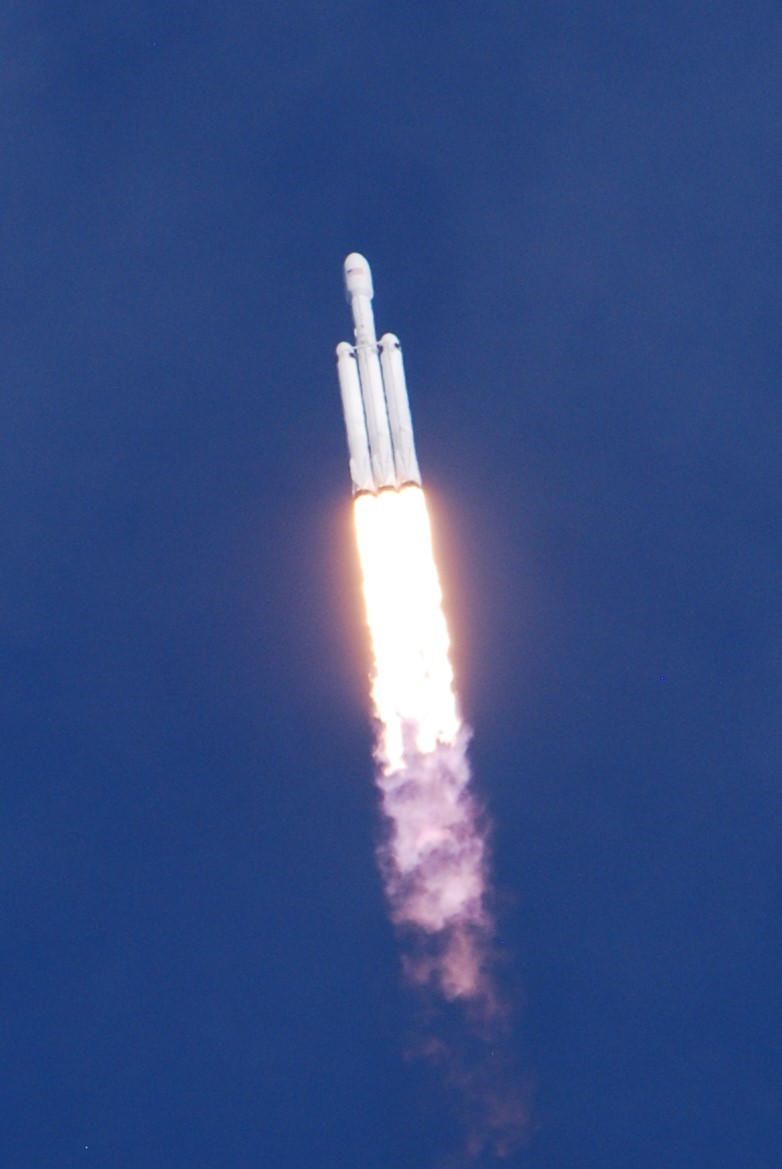Economy

SpaceX Falcon Launch a Heavy Experience
Written by Tim Triplett
February 9, 2018
The Fourth of July has always been my favorite holiday, so maybe that’s why experiencing a space launch up close evoked so many of the same strong emotions.
I was at Cape Canaveral in Florida on Tuesday, sitting in the “Feel the Heat” section for the historic test flight of the Falcon Heavy rocket, the latest design from billionaire entrepreneur Elon Musk and his SpaceX crew. The 230-foot rocket was equipped with 27 engines boasting the combined thrust of 18 Boeing 747 jumbo jets. Musk, who is no stranger to publicity, put his own cherry-red Tesla Roadster with a space-suited Starman mannequin behind the wheel into the rocket’s nosecone to serve as a dummy payload.
 Like a fireworks display, a rocket launch is a communal experience. A couple thousand of us lucky enough to get a ticket gathered at the Kennedy Space Center for an unobstructed view over the Banana River to the launch site. A couple million Florida residents gathered by the side of the road or paused in place to gaze skyward in hopes of catching a glimpse of history, or perhaps catastrophe, which we all know can be but a faulty O-ring away.
Like a fireworks display, a rocket launch is a communal experience. A couple thousand of us lucky enough to get a ticket gathered at the Kennedy Space Center for an unobstructed view over the Banana River to the launch site. A couple million Florida residents gathered by the side of the road or paused in place to gaze skyward in hopes of catching a glimpse of history, or perhaps catastrophe, which we all know can be but a faulty O-ring away.
Sitting in the stands sipping a cold drink surrounded by other space enthusiasts was very much like many July Fourth picnics, except this time the hours-long wait for the rocket’s red glare grew almost unbearable. With just 15 minutes left in the launch window, we learned that the upper level winds had calmed enough for mission control to give the launch a go. We all cheered like the hometown team had just scored a touchdown.
We could see and hear the seconds tick down on video monitors positioned nearby. We all joined in the final countdown at the top of our lungs. Then, many of us peering through binoculars or the telephoto lens of a camera, a cloud of smoke appeared followed by a flash of light as the engines ignited 3.9 miles away. There was an odd pause for a few seconds before the crackling sound of the afterburners reached us, and then the shockwave hit us in the chest with a thump.
The rocket seemed to hesitate for a moment before clearing the launch pad then shooting impossibly fast into the blue. Passing into and out of one of the few clouds in the sky gave the visual a beautiful three-dimensional appearance. But the show was not over; this was a double feature. A couple of heart-pounding minutes later two boosters separated from the main rocket and plummeted earthward. The crowd gasped at the sight of two tiny pinpoints of light when the burners on the boosters fired to slow their descent and steer them miraculously to landing pads visible 10 miles away. Retrieval and reuse of the aluminum-lithium boosters saves millions in the cost of launching satellites and other payloads. As a recycler, Elon Musk is out of this world.
A Rising Market for Metals
Rocket launches are hardly a new phenomenon. To date, more than 5,000 have been sent skyward. What is new is the level of private investment in commercial space flight, which used to be largely the purview of government programs in the U.S., Russia and Europe.
Competition from private enterprise is driving innovation and dramatically lowering the cost of space technology. SpaceX is perhaps the best known commercial player, touting its plans to send reusable rockets to Mars a decade ahead of NASA. United Launch Alliance, a rocket-making joint venture between Lockheed Martin and Boeing and the chief competitor of SpaceX for defense missions, plans to fly by 2020. ULA partnered with Blue Origin in 2014 to develop a new low-cost rocket booster. Blue Origin is a privately funded aerospace manufacturer and spaceflight services company set up by Amazon.com founder Jeff Bezos. Blue Origin is planning to fly its own new orbital launch vehicle, the New Glenn, in 2020. American aerospace manufacturer Orbital ATK built the Antares and other rockets for NASA and hopes to have its own entrant in the competition by 2021. Active programs using a combination of public and private funding include the European Space Agency’s Ariane 5, Russia’s Soyuz and Proton, not to mention China’s ambitious space program.
Clearly, the commercial aerospace and space transport markets are expanding at an unpredicted pace and represent new opportunities for suppliers of countless materials, including advanced aluminums and other exotic alloys, and even lightweight high-strength steels. The impact of the planet-wide R&D effort on metallurgical science could be profound. It appears the sky’s the limit on this new market for metals.
By Tim Triplett, Tim@SteelMarketUpdate.com, photography by Paul Grinvalds

Tim Triplett
Read more from Tim TriplettLatest in Economy

Supply chains, end-users brace for impact from tariffs
Supply chains are working through what the tariffs mean for them

ISM: Manufacturing expansion loses steam after two months of growth
US manufacturing activity slowed in March after two straight months of expansion, according to supply executives contributing to the Institute for Supply Management (ISM)’s latest report.

Chicago Business Barometer rose to 16-month high in March
The Chicago Business Barometer increased for the third-consecutive month in March. Despite this, it still reflects contracting business conditions, as it has since December 2023.

Durable goods orders rise again in February
Transportation equipment led the increase, rising 1.5% to $98.3 billion.

Consumer confidence falls for fourth consecutive month
People remain concerned about inflation, trade policies, and tariffs.
